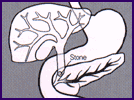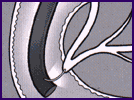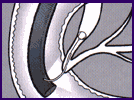ERCP
What is ERCP?

ERCP is a specialized technique used to study the ducts (drainage routes) of the gallbladder, pancreas, and liver (the drainage channels from the liver are called bile ducts or biliary ducts). An endoscope (flexible thin tube that allows the physician to see inside the bowel) is passed through the mouth, esophagus, and stomach into the duodenum (first part of the small intestine). After the common opening to ducts from the liver and pancreas is visually identified, a catheter (narrow plastic tube) is passed through the endoscope into the ducts. Contrast material (“dye”) is then injected gently into the ducts (pancreatic or biliary) and x-ray films are taken.
What preparation is required?

It is necessary to have a completely empty stomach for the best possible examination. You should therefore fast for at least 6 hours (and preferably overnight) before the procedure.An allergy to iodine containing drugs (contrast material or “dye”) is not a contraindication to ERCP, but it should be discussed with your physician prior to the procedure. The physician performing the procedure should be informed of any medications that you take regularly, any heart or lung conditions (or any other major diseases), and whether you have any drug allergies.
Someone must accompany you home from the procedure because of the sedation used during the examination. Even if you feel alert after the procedure, your judgment and reflexes may be impaired by the sedation for the rest of the day, making it unsafe for you to drive or operate any machinery. If a complication occurs, you may need to be hospitalized until it resolves.
What can be expected during ERCP?

Your physician will discuss why ERCP is being performed, potential complications from ERCP, and alternative diagnostic or therapeutic tests that are available. A local anesthetic may be applied to your throat and an intravenous sedative may be given to make you more comfortable during the test. Some patients also receive antibiotics before the procedure. The test begins with you lying on your left side on an x-ray table. The endoscope is passed through the mouth, esophagus, and stomach into the duodenum. The instrument does not interfere with breathing. Air is introduced through the instrument and may cause temporary bloating during and after the procedure. The injection of contrast material into the ducts rarely causes discomfort.
What are possible complications of ERCP?

ERCP is generally a well-tolerated procedure when performed by physicians who have had special training and experience in this technique. Localized irritation of the vein into which medications were given may rarely cause a tender lump that may last several weeks. The application of heat packs or hot moist towels to the area may ease the discomfort.
Major complications requiring hospitalization can occur but are uncommon during diagnostic ERCP. They include serious pancreatitis and even more rarely infections, bowel perforation, and bleeding. Another potential risk of ERCP is an adverse reaction to the sedative used. The risks of the procedure vary with the indications for the test, what is found during the procedure, what therapeutic intervention is undertaken, and the presence of other major medical problems, eg, heart or lung diseases. Your physician will tell you what is your likelihood of complications before undergoing the test.
If therapeutic ERCP is performed (cutting an opening in the bile duct, stone removal, dilation of a stricture, stent or drain replacement, etc), the possibility of complications is higher than with diagnostic ERCP; complications include pancreatitis, bleeding, and bowel perforation. These risks must be balanced against the potential benefits of the procedure and the risks of alternative surgical treatment of the condition. Often these complications can be managed without surgery, but occasionally they do require corrective surgery.
What can be expected following ERCP?
If you are having ERCP as an outpatient, you will be kept under observation until most of the effects of the medications have worn off. Evidence of any complications of the procedure will be looked for and hospitalization may be advised if further observation is necessary. You may experience bloating or pass gas because of the air introduced during the examination. You may resume your usual diet unless you are instructed otherwise.
To the patient
Because education is an important part of comprehensive medical care, you have been provided with this information to prepare you for this procedure. If you have any questions about your need for ERCP, alternative approaches to your problem, the cost of the procedure, methods of billing, or insurance coverage, do not hesitate to speak to your doctor or doctor’s office staff about it. Most endoscopists are highly trained specialists and welcome your questions regarding their credentials and training. If you have questions that have not been answered, please discuss them with the endoscopy nurse or your physician before the examination begins.

